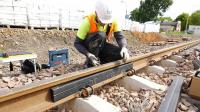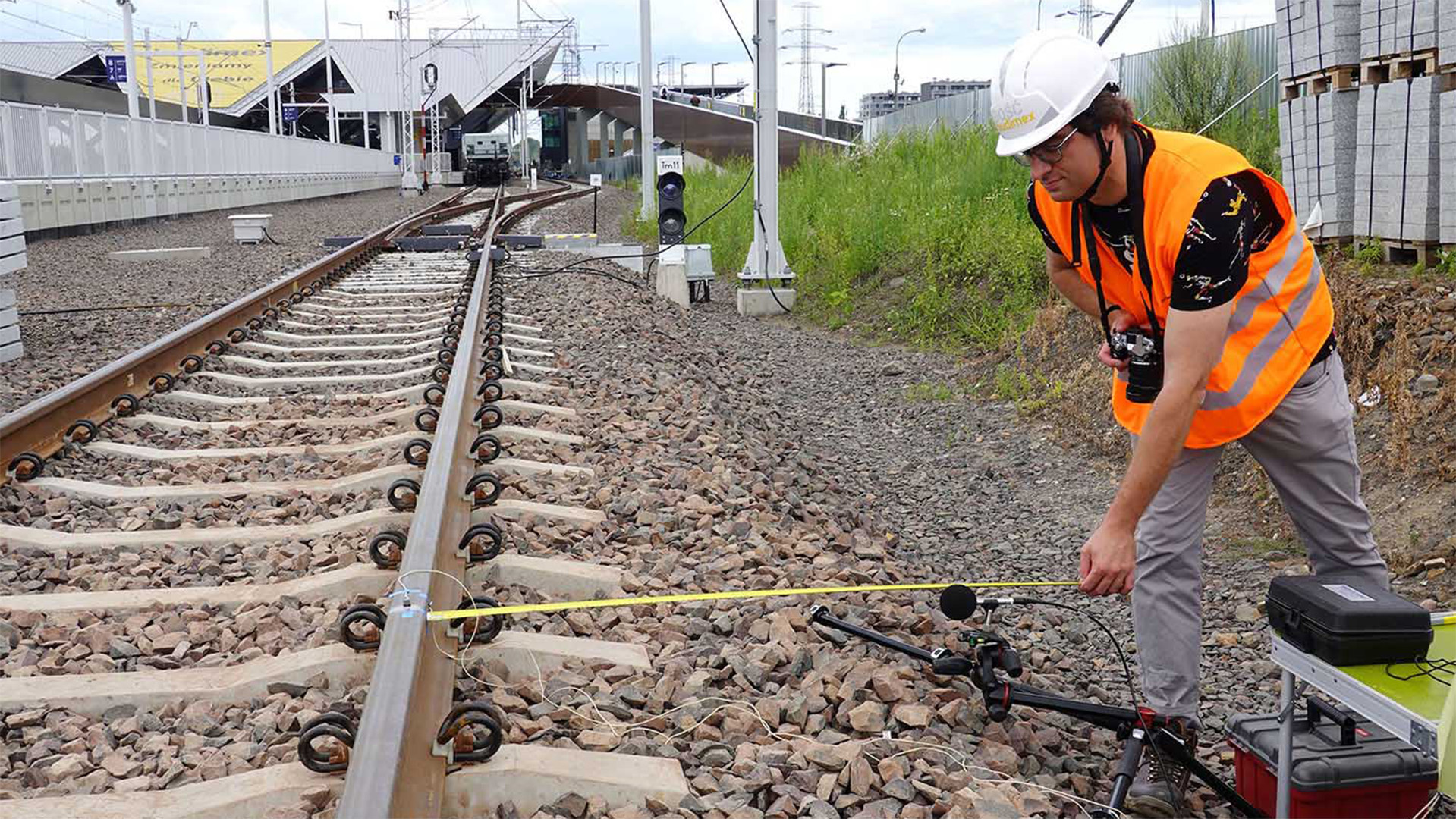Noise and vibration protection – BRIK railway projects at WUT
Cezary Kraśkiewicz, PhD, and Prof. Artur Zbiciak led two major BRIK (Railway Innovation Research and Development) projects at Warsaw University of Technology (WUT). These initiatives resulted in the development of prototype technologies aimed at reducing noise and vibrations caused by railway traffic. In January 2025, PKP Polskie Linie Kolejowe S.A. signed perpetual license agreements for the use of these solutions, marking a milestone in their practical implementation.
Kraśkiewicz, PhD, affiliated with WUT's Faculty of Civil Engineering since 2012, specializes in mitigating the negative dynamic effects of rail, tram, and metro traffic on surrounding environments.
– The goal is to reduce noise and vibrations that degrade the quality of life for nearby residents and building users – explains Kraśkiewicz, PhD. – This focus began with my doctoral research under Prof. Zbiciak, during which I developed several laboratory setups to test vibroacoustic isolators for rail tracks. These setups eventually attracted commissioned research from industry partners.
Shortly thereafter, PKP PLK S.A. and the National Centre for Research and Development (NCBR) launched the BRIK competition. Two topics related to rail infrastructure noise and vibration mitigation were included in the research agenda. These solutions could offer alternatives to extensive noise barriers that disrupt wildlife corridors.
– Despite having only two months, we submitted two separate project proposals – says Kraśkiewicz, PhD. – Our previous industrial collaborations helped us assemble a strong consortium. A year later, both proposals received top rankings and were granted funding, setting the stage for my leadership in one project and research coordination in both.
Kraśkiewicz, PhD, led the project "Innovative Solutions for Protecting People and the Environment from Railway Noise" (InRaNoS), which developed rail-side noise dampers. He also coordinated lab and field testing for the project "Innovative Solutions for Protecting People and Buildings from Railway-Induced Vibrations" (InRaViS).
Professor Artur Zbiciak, led the InRaViS project, which produced prototypes of UBM mats and USP pads for vibration reduction. He also oversaw numerical modelling (key R&D personnel) within the InRaNoS project.
Noise and vibration mitigation
As part of the BRIK initiative, two flagship projects were carried out, addressing current challenges in environmental protection related to the negative impacts of rail traffic (vibrations and noise) along railway lines:
- Noise Mitigation Solution for Human and Environmental Protection
As part of the project, prototypes of solutions aimed at reducing railway noise levels were developed. Geometric and material parameters were optimized based on finite element method (FEM) numerical simulations. The effectiveness of rail-side and track-mounted dampers (absorbers) was tested, including trials conducted at the test site of the Faculty of Civil Engineering at Warsaw University of Technology and on Railway Line No. 9 near Nowy Dwór Mazowiecki and Pomiechówek.
During tests on the operational railway line, environmental noise measurements were performed under real-world conditions (i.e., during actual train passages) to evaluate the performance of the rail-side dampers.
The results of the conducted research enabled the development of guidelines for the implementation of solutions (acoustic dampers) on railway lines. The application of these guidelines in cooperation with the railway industry will contribute to reducing investment and operational costs by ensuring appropriate selection of mitigation measures adequate to the scale of exceedance of permissible noise levels.
Additionally, the findings from the conducted research were used to develop data that can be directly applied in computational programs used for modelling environmental noise propagation.
- Solutions for Vibration Protection for People and Buildings
This project involved the creation and testing of sample/prototype vibration-isolation solutions and evaluating their effectiveness in reducing vibration levels caused by railway traffic, transmitted to buildings and their occupants. It also included laboratory testing for operational durability – such as fatigue resistance and weather endurance – of four types of vibration isolators used in both ballasted and slab track systems: under-sleeper pads (USP), under-ballast mats (UBM), under-slab mats (USM), and encased block support systems (EBS). These tests were preceded by extensive FEM numerical analyses using advanced simulation tools.
The main outcome was a set of guidelines defining the effectiveness and appropriate application scope for each solution, along with recommendations to reduce operational costs by selecting mitigation methods tailored to the scale of exceedance. The research also produced guidelines for incorporating vibration mitigation techniques into engineering simulations.
– The results of these projects will bring tangible economic, environmental, and social benefits by improving the selection of track system components and extending infrastructure durability. They will also enhance comfort for residents and building users along railway routes by reducing vibrations and secondary noise – adds Cezary Kraśkiewicz, PhD.
The two BRIK projects conducted at the Faculty of Civil Engineering involved a consortium of five entities – two industry partners and three research institutions—with the Faculty serving as project leader. Funding was provided by the EU’s Smart Growth Operational Programme and PKP Polskie Linie Kolejowe S.A.
The consortium included: Warsaw University of Technology, Railway Institute, Institute of Environmental Protection – National Research Institute, Budimex S.A., and Anito 2 Sp. z o.o.
– Implementing these projects required extensive research teams – about 50 people from the Faculty of Civil Engineering alone were involved, including specialists in FEM simulations, laboratory testing, and field measurements at test sites. We also worked with staff from other WUT faculties – such as Automotive and Construction Machinery Engineering and Production Engineering. Within the consortium, we exchanged expertise with environmental acoustics specialists, technologists in construction product manufacturing and certification, and practicing railway engineers an invaluable experience for researchers – emphasizes Cezary Kraśkiewicz, PhD.
Over several years, the projects encountered real challenges, including force majeure events such as the COVID-19 pandemic, which delayed or hindered some tests, necessitating schedule adjustments.
Additionally, the nature of the projects also required completing occupational health and safety training and obtaining access permits from the Railway Protection Service before beginning any on-track work. Some field tests could only be conducted during several-hour traffic breaks – exclusively at night – while acoustic testing required specific weather conditions for reliable results.
Patents for noise and vibration reduction
The projects led to the development of patented technologies:
- "Rail-side noise damper" – designed to reduce noise emissions from rail traffic using a deformable casing with resonating elements and air cavities aligned with rail vibration direction. (Patent application no.: P.441392, filed: 06.07.2022)
- "Method for manufacturing prefabricated noise-reducing elements" – a patented multi-stage process culminating in the exposure of closed pores in porous concrete aggregate. (Patent application no.: P.442276, filed: 14.09.2022)
- "Damping mat" – used in railway track systems to reduce vibrations from trains. Its inner layer, divided by partitions, is filled with loose recycled materials (e.g., tire scraps, rubber fibres) and equipped with external pneumatic air valves. (Patent application no.: P.440999, filed: 22.04.2022)
- "Under-sleeper pad" – attached to the underside of railway sleepers and supported on ballast, made of elastomer with pseudo-elastic phase-change material reinforcement. (Patent application no.: P.444276, filed: 21.03.2023)
The significance of the consortium’s work is underscored by numerous awards:
- First-degree team award from the Rector of WUT for scientific achievements in 2021–2022, and second-degree team award for 2019–2020, both recognizing publication cycles related to the projects.
- Second place in the "Mazovia Innovator" competition (Innovative Scientist category) and a scholarship from the Minister of Education and Science for Dr. Kraśkiewicz’s doctoral dissertation: "Identification and Selection of Material Properties of Selected Vibroacoustic Isolators in Railway Track Systems". The dissertation's subject was closely aligned with the projects.
To date, the BRIK I projects have resulted in over a dozen scientific articles in highly ranked journals, including those published by Elsevier, the journal "Materials," and journals of the Polish Academy of Sciences.
Projects in practice
Both projects were completed in May 2023, after a five-year implementation period that began in June 2018. They are currently in their sustainability phase.
In January 2025, PKP Polskie Linie Kolejowe S.A. signed perpetual license agreements for the use of the project results developed under the joint BRIK initiative of the National Centre for Research and Development and PKP PLK S.A. The projects were completed in collaboration with five entities, including research institutions and industry partners. Signing the agreements marked an important milestone in implementing project outcomes launched in 2017
The license agreements were signed with the contractors:
- "Innovative Solutions for Protecting People and Buildings from Railway-Induced Vibrations" – implemented by the consortium: Warsaw University of Technology, Railway Institute, Institute of Environmental Protection – National Research Institute, Budimex S.A., and Anito 2 Sp. z o.o.
- "Innovative Solutions for Protecting People and the Environment from Railway Noise" – implemented by the consortium: Warsaw University of Technology, Institute of Environmental Protection – National Research Institute, Budimex S.A., and Anito 2 Sp. z o.o.
These agreements allow for perpetual, royalty-free, and open (non-exclusive) use of the developed solutions without territorial restrictions. Intellectual property and production rights remain with the project consortiums.
PKP PLK is currently analysing which internal documents (e.g., standards, guidelines, instructions) could incorporate the project results from the first BRIK competition.




